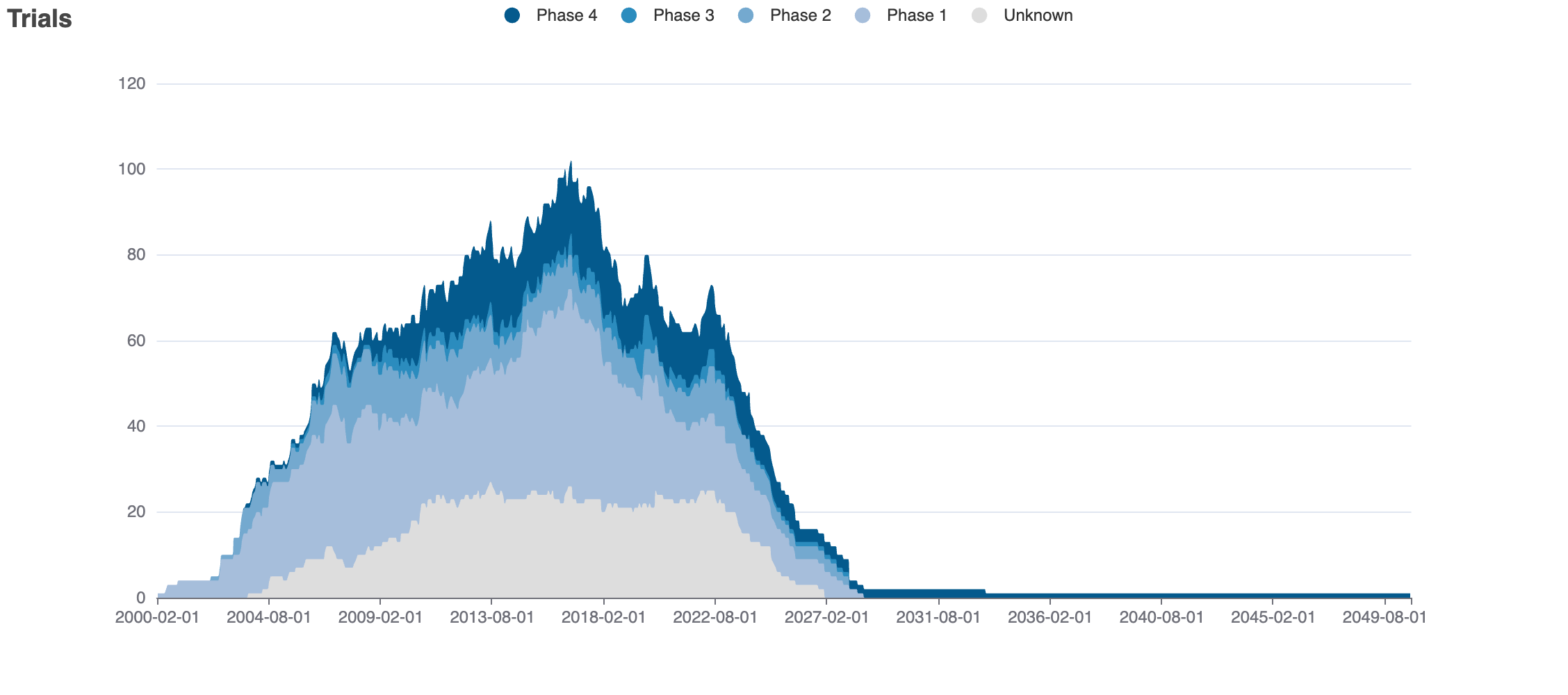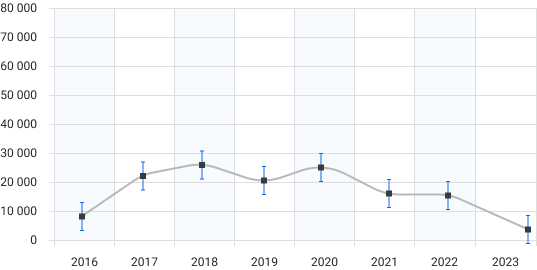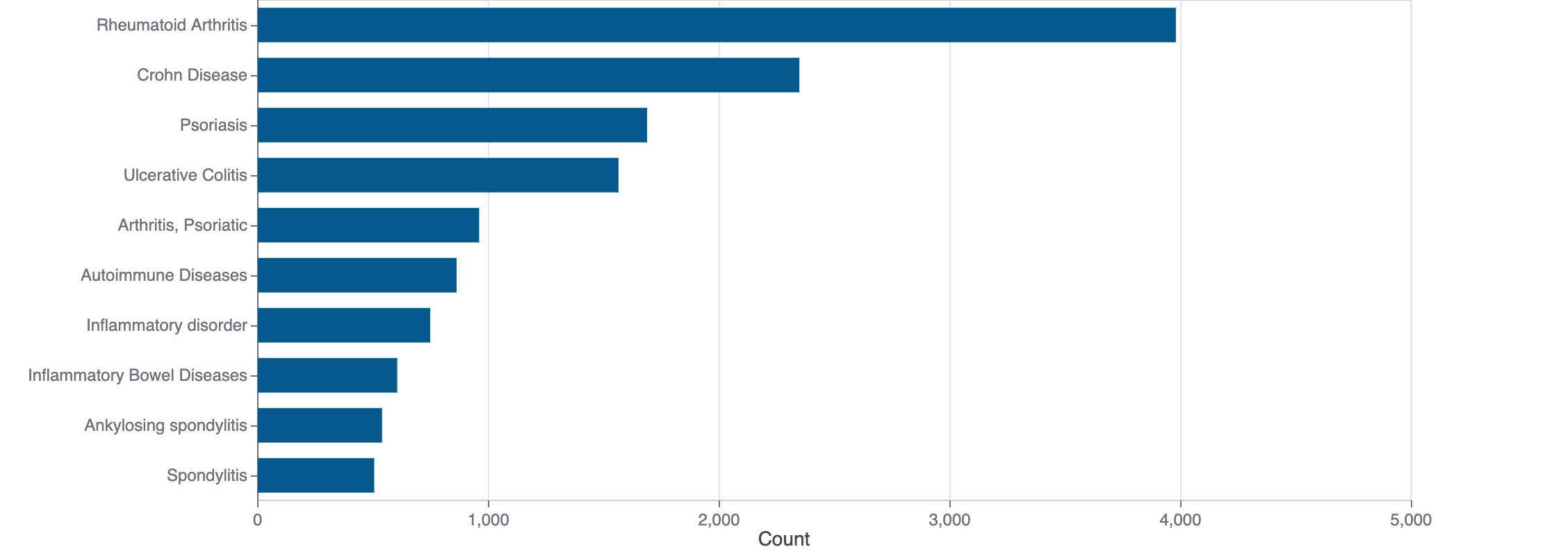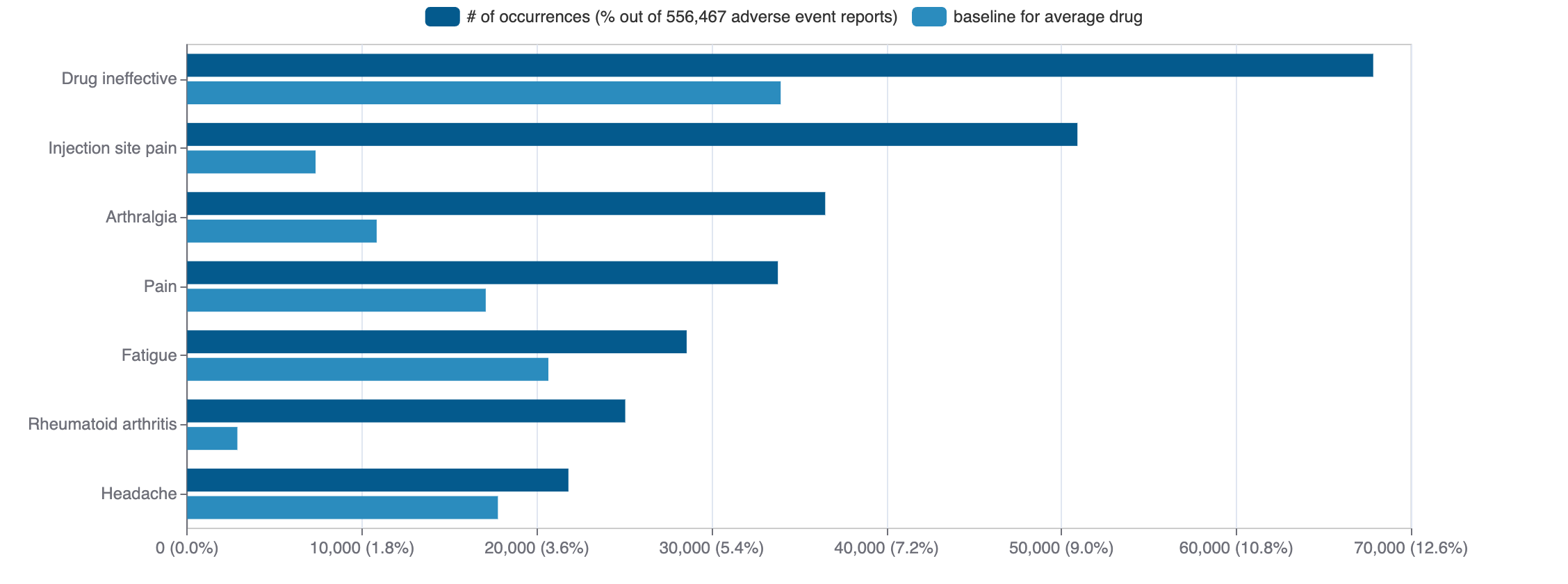Cyproheptadine
Cyproheptadine (cyproheptadine) is a small molecule pharmaceutical. Cyproheptadine was first approved as Periactin on 1982-01-01. It is used to treat allergic rhinitis perennial, blepharospasm, cluster headache, dyskinesias, and nelson syndrome amongst others in the USA. The pharmaceutical is active against histamine H1 receptor. In addition, it is known to target alpha-1A adrenergic receptor, alpha-1B adrenergic receptor, 5-hydroxytryptamine receptor 7, 5-hydroxytryptamine receptor 6, and alpha-1D adrenergic receptor.
Download report
Favorite
Events Timeline
Commercial
Clinical
Drug
Target
Variants
Financial
Trends
Safety
Events Timeline
5D
1M
3M
6M
YTD
1Y
2Y
5Y
Max
Events
FDA approval date
EMA approval date
Patent expiration date
Study first post date
Last update post date
Start date
Primary completion date
Completion date
Results first post date

Mock data
Subscribe for the real data
Subscribe for the real data
Commercial
Therapeutic Areas
Trade Name
FDA
EMA
Cyproheptadine (discontinued: Cyproheptadine, Periactin)
Drug Products
FDA
EMA
New Drug Application (NDA)
New Drug Application (NDA)
Abbreviated New Drug Application (ANDA)
Abbreviated New Drug Application (ANDA)
Cyproheptadine hydrochloride
Tradename | Company | Number | Date | Products |
|---|---|---|---|---|
| PERIACTIN | Merck & Co | N-012649 DISCN | 1982-01-01 | 1 products, RLD |
| PERIACTIN | Merck & Co | N-013220 DISCN | 1982-01-01 | 1 products, RLD |
Hide discontinued
Labels
FDA
EMA
Brand Name | Status | Last Update |
|---|---|---|
| cyproheptadine | ANDA | 2023-10-05 |
| cyproheptadine hydrochloride | ANDA | 2025-12-02 |
| cyproheptadine hydrochloride solution | ANDA | 2025-10-21 |
Indications
FDA
EMA
Agency Specific
FDA
EMA
No data
Patent Expiration
No data
HCPCS
No data
Clinical
Clinical Trials
97 clinical trials
View more details

Mock data
Subscribe for the real data
Subscribe for the real data
Indications Phases 4
Indication | MeSH | Ontology | ICD-10 | Ph 1 | Ph 2 | Ph 3 | Ph 4 | Other | Total |
|---|---|---|---|---|---|---|---|---|---|
| Allergic rhinitis | D065631 | — | J30.9 | — | — | 2 | 2 | 1 | 5 |
| Rhinitis | D012220 | EFO_0008521 | J31 | — | — | 2 | 2 | 1 | 5 |
| Allergic rhinitis perennial | D012221 | EFO_1001417 | J30.89 | — | — | — | 2 | 1 | 3 |
Indications Phases 3
Indication | MeSH | Ontology | ICD-10 | Ph 1 | Ph 2 | Ph 3 | Ph 4 | Other | Total |
|---|---|---|---|---|---|---|---|---|---|
| Allergic rhinitis seasonal | D006255 | EFO_0003956 | J30 | — | — | 2 | — | 1 | 3 |
Indications Phases 2
No data
Indications Phases 1
Indication | MeSH | Ontology | ICD-10 | Ph 1 | Ph 2 | Ph 3 | Ph 4 | Other | Total |
|---|---|---|---|---|---|---|---|---|---|
| Rheumatoid arthritis | D001172 | EFO_0000685 | M06.9 | 1 | — | — | — | — | 1 |
| Arthritis | D001168 | EFO_0005856 | M05-M14 | 1 | — | — | — | — | 1 |
Epidemiology
Epidemiological information for investigational and approved indications
View more details
Drug
General
| Drug common name | Cyproheptadine |
| INN | cyproheptadine |
| Description | Cyproheptadine is the product resulting from the formal oxidative coupling of position 5 of 5H-dibenzo[a,d]cycloheptene with position 4 of 1-methylpiperidine resulting in the formation of a double bond between the two fragments. It is a sedating antihistamine with antimuscarinic and calcium-channel blocking actions. It is used (particularly as the hydrochloride sesquihydrate) for the relief of allergic conditions including rhinitis, conjunctivitis due to inhalant allergens and foods, urticaria and angioedema, and in pruritic skin disorders. Unlike other antihistamines, it is also a seratonin receptor antagonist, making it useful in conditions such as vascular headache and anorexia. It has a role as a H1-receptor antagonist, a serotonergic antagonist, an antipruritic drug, an anti-allergic agent and a gastrointestinal drug. It is a member of piperidines and a tertiary amine. |
| Classification | Small molecule |
| Drug class | — |
| Image (chem structure or protein) |  |
| Structure (InChI/SMILES or Protein Sequence) | CN1CCC(=C2c3ccccc3C=Cc3ccccc32)CC1 |
Identifiers
| PDB | — |
| CAS-ID | 129-03-3 |
| RxCUI | — |
| ChEMBL ID | CHEMBL516 |
| ChEBI ID | 4046 |
| PubChem CID | 2913 |
| DrugBank | DB00434 |
| UNII ID | 2YHB6175DO (ChemIDplus, GSRS) |
Target
Agency Approved
No data
Alternate
ADRA1D
ADRA1D
SETD7
SETD7
Organism
Homo sapiens
Gene name
ADRA1D
Gene synonyms
ADRA1A
NCBI Gene ID
Protein name
alpha-1D adrenergic receptor
Protein synonyms
adrenergic, alpha -1D-, receptor, adrenergic, alpha-1A-, receptor, Alpha-1A adrenergic receptor, Alpha-1D adrenoceptor, Alpha-1D adrenoreceptor, Alpha-adrenergic receptor 1a
Uniprot ID
Mouse ortholog
Adra1d (11550)
alpha-1D adrenergic receptor (P97714)
Variants
No data
Financial
Revenue by drug
$
€
£
₣
No data
Estimated US medical usage
Cyproheptadine
Total medical expenditures per year (USD, in millions)

Mock data
Subscribe for the real data
Subscribe for the real data
Number of persons purchased

Mock data
Subscribe for the real data
Subscribe for the real data
Number of purchases

Mock data
Subscribe for the real data
Subscribe for the real data
Refill frequency

Mock data
Subscribe for the real data
Subscribe for the real data
Price per prescription (USD)

Mock data
Subscribe for the real data
Subscribe for the real data
Tabular view
Trends
PubMed Central
Top Terms for Disease or Syndrome:

Mock data
Subscribe for the real data
Subscribe for the real data
Additional graphs summarizing 3,323 documents
View more details
Safety
Black-box Warning
No Black-box warning
Adverse Events
Top Adverse Reactions

Mock data
Subscribe for the real data
Subscribe for the real data
966 adverse events reported
View more details
© 2020-2025 Collaborative Drug Discovery Inc. (CDD) | Terms of Use